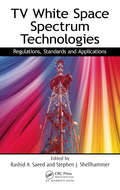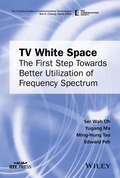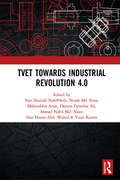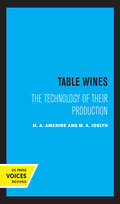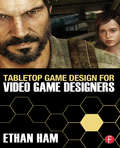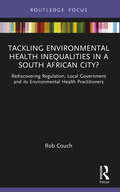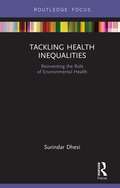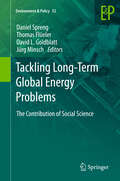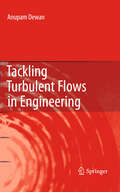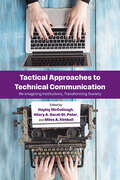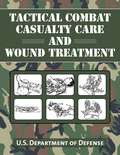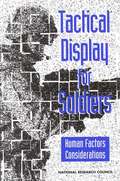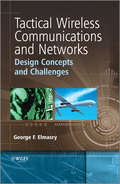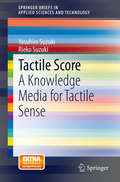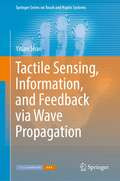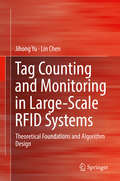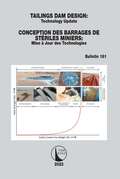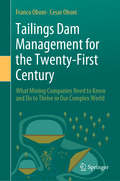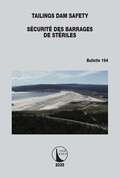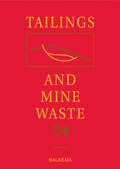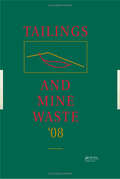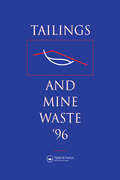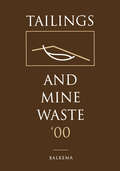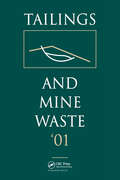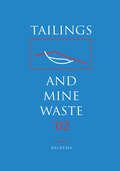- Table View
- List View
TV White Space Spectrum Technologies: Regulations, Standards, and Applications
by Rashid A. Saeed Stephen J. ShellhammerAlthough sophisticated wireless radio technologies make it possible for unlicensed wireless devices to take advantage of un-used broadcast TV spectra, those looking to advance the field have lacked a book that covers cognitive radio in TV white spaces (TVWS). Filling this need, TV White Space Spectrum Technologies: Regulations, Standards and Applic
TV White Space: The First Step Towards Better Utilization of Frequency Spectrum
by Ser Wah Oh Edward Peh Ming-Hung Tao Yugang MaProvides an in-depth coverage of TV White Space Technology (TVWS) and the various challenges of its new innovations This book covers the full spectrum of TVWS technology including regulations, technology, standardizations, and worldwide deployments. It begins with an introduction to cognitive radio and TVWS. The regulation activities in TVWS throughout North America, Europe, and Asia Pacific are covered in depth. After a discussion of regulations, the authors examine the standardizations developed to specify the enabling technologies of TVWS systems. The following chapter focuses on the key technologies that differentiate TVWS from a conventional wireless communication system. Describes various worldwide use cases and deployments based on the needs of the consumers Covers IEEE 802.19.1, IEEE 802.22, IEEE 802.11af, IEEE 802.15.4m, and IETF protocol for Accessing White Spaces Studies the market and commercial potential of TVWS and other spectrum sharing technologies Discusses technological trends in spectrum sharing and additional applications that could leverage on TVWS and other spectrum sharing technologies TV White Space: The First Step Towards Better Utilization of Frequency Spectrum is written for telecommunications/networks operators, researchers, engineers, government regulators, technical managers, and network equipment manufacturers.
TVET Towards Industrial Revolution 4.0: Proceedings of the Technical and Vocational Education and Training International Conference (TVETIC 2018), November 26-27, 2018, Johor Bahru, Malaysia
by Mahyuddin Arsat Dayana Farzeeha Ali Yusri Kamin Nur Hazirah Noh@Seth Norah Md Noor Ahmad Nabil Md. Nasir Nur Husna Abd. WahidDemand for Technical and Vocational Education and Training (TVET) in Malaysia has been growing extensively, involving various involvement from industry and academia. Research related to the improvement of TVET in Malaysia, as well as the sustainability of TVET especially in the Industrial Revolution 4.0 era are among the topics of interest presented in this book. The input from this research provides better insight on the current situation of TVET in Malaysia as a whole, opening up various research fields to be explored in the future by other researchers. The development of education on an international level has sparked the idea for educators and academia to find solutions on issues of education relevant to the 21st century, hence this book shares the strategies and efforts needed to strengthen the education in various regions and make sure it is on par with education in developed countries.
Table Wines: The Technology of Their Production
by M. A. Amerine M.A. JoslynThis title is part of UC Press's Voices Revived program, which commemorates University of California Press’s mission to seek out and cultivate the brightest minds and give them voice, reach, and impact. Drawing on a backlist dating to 1893, Voices Revived makes high-quality, peer-reviewed scholarship accessible once again using print-on-demand technology. This title was originally published in 1970.
Tabletop Game Design for Video Game Designers
by Ethan Ham<p>Learn the mechanics that take your game from an idea to a playable product. <p>Do you aspire to be a game designer but aren’t sure where to begin? Tabletop Game Design for Video Game Designers guides you through your initial attempts to design game mechanics. It goes beyond simple description and definition to explore in detail the issues that designers grapple with for every game they create. <p>Learning to design tabletop games builds a solid foundation for game designers and provides methods that can be applied towards creating paper prototypes of computer-targeted games. Presented in a step-by-step format, Tabletop Game Design for Video Game Designers helps the reader understand how the game design skills that are acquired through creating tabletop games can be used when designing video games. Fully playable games accompany every topic so you can truly understand and experience each component that goes into game creation. <p>Tabletop Game Design for Video Game Designers includes: <p> <li>Simple, highly focused games that can be played, analyzed, improved, and/or modified in conjunction with a particular topic in the book. <li>Integrated game design exercises, chapter learning objectives, and in-text sidebars to provide further examples to apply directly to your game creation process. <li>A companion website (www.funmines.com) which includes: "print & play" tabletop games, links to online games, game design resources, and articles about designing and developing games.</li> </p>
Tackling Environmental Health Inequalities in a South African City?: Rediscovering Regulation, Local Government and its Environmental Health Practitioners (Routledge Focus on Environmental Health)
by Rob CouchSouth Africa is widely recognised as a middle-income, industrialised nation, but it also ranks amongst the most unequal countries in the world in terms of its income distribution and human development. Environmental health remains a considerable public health challenge in the 21st century as Environmental Health Practitioners (EHPs) try to tackle local environmental health inequalities in the face of historically disadvantaged populations suspicious of their motives and demands that far exceed any resources available. Based on an empirical research project that explores how local government Environmental Health Practitioners regulate environmental health in one of South Africa’s largest, fastest growing and most unequal cities, Urbington, this book explores the many influences on their decision-making including the limits of the law, organisational controls, the views of EHPs themselves and their relations with businesses, communities, politicians and others. Tackling Environmental Health Inequalities in a South African City? argues that if we are to meet the environmental health challenges of the 21st century, it is in our best interests to rediscover this vital local public health workforce. This book is essential reading for students, practitioners and policymakers in environmental health and public health, as well as those interested in urban development and policy, particularly in African cities.
Tackling Health Inequalities: Reinventing the Role of Environmental Health (Routledge Focus on Environmental Health)
by Surindar Kishen DhesiAlthough environmental health has received some recognition as a field which can positively impact on the social determinants of health, it remains little known outside its immediate sphere of influence. There is also limited literature available to support the potential impact of the profession in public health policy circles, and there has been an overreliance on anecdotal rather than firm evidence. This book presents the findings of an empirical research project focussed on public health policymaking (English Health and Wellbeing Boards), health inequalities and environmental health and provides an insight to the environmental health profession and routes of impact and influence. It discusses environmental health in the context of public health, the role of the profession, issues of visibility and opportunities for impact in today’s policy landscape. In particular, a focus on the local government context is timely given the shifting of the public health function from the National Health Service to local authorities. This book is essential reading for students, practitioners and policymakers in the fields of environmental health and public health.
Tackling Long-Term Global Energy Problems: The Contribution of Social Science
by Daniel Spreng Thomas Flüeler David L. Goldblatt Jürg MinschThis book makes a case for a multidisciplinary and transdisciplinary approach to energy research--one that brings more of the social sciences to bear. Featuring eight studies from across the spectrum of the social sciences, each applying multiple disciplines to one or more energy-related problems, the book demonstrates the strong analytical and policy-making potential of such a broadened perspective. Case studies include: energy transitions of households in developing countries, the 'curse of oil', politics and visions for renewables, economics and ethics in emissions trading, and carbon capture and storage.
Tackling Turbulent Flows in Engineering
by Anupam DewanThe emphasis of this book is on engineering aspects of fluid turbulence. The book explains for example how to tackle turbulence in industrial applications. It is useful to several disciplines, such as, mechanical, civil, chemical, aerospace engineers and also to professors, researchers, beginners, under graduates and post graduates. The following issues are emphasized in the book: - Modeling and computations of engineering flows: The author discusses in detail the quantities of interest for engineering turbulent flows and how to select an appropriate turbulence model; Also, a treatment of the selection of appropriate boundary conditions for the CFD simulations is given. - Modeling of turbulent convective heat transfer: This is encountered in several practical situations. It basically needs discussion on issues of treatment of walls and turbulent heat fluxes. - Modeling of buoyancy driven flows, for example, smoke issuing from chimney, pollutant discharge into water bodies, etc
Tactical Approaches to Technical Communication: Reimagining Institutions, Transforming Society (SUNY series, Studies in Technical Communication)
by Hayley McCullough; Hilary A. Sarat-St. Peter; Miles A. KimballDelves into how individuals tactically exist within communicative systems, carving out spaces for themselves in places they don't necessarily fit.In 1984, Michel de Certeau described the terms "strategies" as how institutions communicate their wants/demands/desires and "tactics" as how individuals navigate these potentially hostile, unwelcoming systems. A little over two decades later, Miles A. Kimball solidified the idea of tactical technical communication, laying the foundations for a new area of inquiry and scholarship. Today, many academics and researchers have imbued the concept of tactical technical communication with their own ideas and perspectives. This essay collection spotlights a meaningful diversity of tactical technical communication scholarship, exploring topics like the feminist punk magazine BIKINI KILL, the phenomenon of copwatching, the usage of fictional narratives in technical writing courses, and the challenges of LBGTQ+ visibility in local libraries. In many ways, the contributors are partaking in their own forms of tactical communication as they carve out spaces for themselves and their ideas within the academic discourse.
Tactical Combat Casualty Care and Wound Treatment
by U.S. Department of DefenseMilitary surgeons must assume a leadership role in combat casualty care in circumstances that are far less than ideal. This handbook provides much of the information needed to tackle these issues and features state-of-the-art principles and practices of forward trauma surgery as used by military physicians in far flung locations around the globe. In this volume you’ll learn such integral skills as: * Tactical field care * Field dressing * Applying pressure dressing * Treating burns * Treating inhalation injuries * And more! Tactical Combat Casualty Care and Wound Treatment is the most trusted and up-to-date manual offered by the Department of Defense for military medical personnel in the field.
Tactical Display for Soldiers: Human Factors Considerations
by Panel on Human Factors in the Design of Tactical Display Systems for the Individual SoldierThis book examines the human factors issues associated with the development, testing, and implementation of helmet-mounted display technology in the 21st Century Land Warrior System.Because the framework of analysis is soldier performance with the system in the full range of environments and missions, the book discusses both the military context and the characteristics of the infantry soldiers who will use the system. The major issues covered include the positive and negative effects of such a display on the local and global situation awareness of the individual soldier, an analysis of the visual and psychomotor factors associated with each design feature, design considerations for auditory displays, and physical sources of stress and the implications of the display for affecting the soldier's workload. The book proposes an innovative approach to research and testing based on a three-stage strategy that begins in the laboratory, moves to controlled field studies, and culminates in operational testing.
Tactical Wireless Communications and Networks
by George F. ElmasryProviding a complete description of modern tactical military communications and networks technology, this book systematically compares tactical military communications techniques with their commercial equivalents, pointing out similarities and differences. In particular it examines each layer of the protocol stack and shows how specific tactical and security requirements result in changes from the commercial approach. The author systematically leads readers through this complex topic, firstly providing background on the architectural approach upon which the analysis will be based, and then going into detail on tactical wireless communications and networking technologies and techniques.Structured progressively: for readers needing an overall view; for those looking at the communications aspects (lower layers of the protocol stack); and for users interested in the networking aspects (higher layers of the protocol stack)Presents approaches to alleviate the challenges faced by the engineers in the field todayFurnished throughout with illustrations and case studies to clarify the notional and architectural approachesIncludes a list of problems for each chapter to emphasize the important aspects of the topics coveredCovers the current state of tactical networking as well as the future long term evolution of tactical wireless communications and networking in the next 50 yearsWritten at an advanced level with scope as a reference tool for engineers and scientists as well as a graduate text for advanced courses
Tactile Score
by Yasuhiro Suzuki Rieko SuzukiThis book deals with one of the most novel advances in natural computing, namely, in the field of tactile sense analysis. Massage, which provides relaxation and stimulation for human beings, is analyzed in this book for the first time by encoding the motions and tactile senses involved. The target audience is not limited to researchers who are interested in natural computing but also includes those working in ergonomic design, biomedical engineering, Kansei engineering, and cognitive science.
Tactile Sensing, Information, and Feedback via Wave Propagation (Springer Series on Touch and Haptic Systems)
by Yitian ShaoA longstanding goal of haptic engineering is to develop haptic interfaces that can provide realistic sensations of touch. A fundamental step towards this goal is to understand what mechanical tactile signals the hand feels during daily touch interactions. This book reveals the complex patterns of mechanical waves propagating throughout the hand that can be elicited even by simple touch interactions, which helps in expanding existing knowledge of tactile function beyond the region of near skin-object contact and inspires new designs for haptic sensing and feedback technologies. The first part of this book describes new methods for capturing dynamic, spatially distributed tactile signals in the whole hand during natural hand interactions. The second part characterizes these signals and evaluates how well and how efficiently they encode the information of touch, relating to the transmission of mechanical waves in hand tissues. The final part demonstrates how these findings can be utilized to create novel haptic effects and tactile displays. Tactile Sensing, Information, and Feedback via Wave Propagation provides a unique view of tactile sensing and feedback and will appeal to researchers, engineers, and students who are interested in learning cutting-edge haptic science and technology.
Tag Counting and Monitoring in Large-Scale RFID Systems: Theoretical Foundations and Algorithm Design
by Lin Chen Jihong YuThis book provides a comprehensive treatment of the theoretical foundation and algorithmic tools necessary in the design of efficient tag counting and monitoring algorithms in emerging RFID systems. The book delivers an in-depth analysis on the following problems ranging from theoretical modeling and analysis, to practical algorithm design and optimization: Stability analysis of the frame slotted Aloha protocol, the de facto standard in RFID tag counting and identification; Tag population estimation in dynamic RFID systems; Missing tag event detection in the presence of unexpected tags; Missing tag event detection in multi-group multi-region RFID systems. The target readers are researchers and advanced-level engineering students interested in acquiring in-depth knowledge on the topic and on RFID systems and their applications.
Tailings Dam Design / Conception des Barrages de Stériles Miniers: Technology Update / Mise à Jour des Technologies (ICOLD Bulletins Series #181)
by Cigb IcoldTailings are produced from the processing of mineral ores and are commonly stored within embankment dams. The design of the dams requires application of sound engineering principles and an understanding of the properties of the tailings. This Bulletin provides a framework for classifying different types of tailings, ranging from ultra-fine to coarse, based on their geotechnical properties and provides typical geotechnical parameters for the different tailings types. Technologies for dewatering tailings to reduce the risk of storage continue to be developed and the different technologies, from thickening to filtration, and re-application of old technologies are presented to illustrate the options available and, where appropriate, typical in situ properties. This bulletin is directed towards a wide audience of stakeholders: designers, owners, regulators, communities and various organizations and provides a reference for communicating tailings properties and the benefits and limitations of technologies. All mining operations, and thereby tailings operations, are unique. There is no one-solution-fits-all. Tailings dam designs need to account for site-specific conditions, such as climate, physiography, geochemistry, geomorphology, seismology, mining processes, environment, and community setting, with the application of technologies playing an important role in developing safe, sustainable tailings facilities. Les stériles miniers sont produits à partir du traitement des minerais et sont généralement stockés derrière des barrages en remblai. La conception des barrages nécessite l'application de principes d'ingénierie solides et une compréhension des propriétés des résidus. Ce bulletin fournit un cadre pour classer différents types de résidus, allant de l'ultra-fin au grossier, en fonction de leurs propriétés géotechniques et propose des paramètres géotechniques typiques pour les différentes sortes de résidus. Les technologies d'assèchement des résidus pour réduire le risque de stockage continuent à être développées ; les différentes technologies, de l'épaississement à la filtration, en passant par l’application des anciennes technologies, sont présentées pour illustrer les options disponibles et, le cas échéant, les propriétés in situ typiques. Ce bulletin s'adresse à un large public d'intervenants : concepteurs, propriétaires, régulateurs, communautés et organisations diverses et fournit une référence pour communiquer les propriétés des résidus et les avantages et les limites des technologies. Toutes les opérations minières et, par conséquent, les traitements des résidus, sont uniques. Il n'y a pas de solution unique pour tous. La conception des barrages de résidus doit tenir compte des conditions propres au site, telles que le climat, la physiographie, la géochimie, la géomorphologie, la sismologie, les processus miniers, l'environnement et le milieu communautaire, l'application de technologies jouant un rôle important dans le développement de parcs à résidus sûrs et durables.
Tailings Dam Management for the Twenty-First Century: What Mining Companies Need to Know and Do to Thrive in Our Complex World
by Franco Oboni Cesar OboniThis book presents a comprehensive approach to address the need to improve the design of tailings dams, their management and the regulation of tailings management facilities to reduce, and eventually eliminate, the risk of such facilities failing. The scope of the challenge is well documented in the report by the United Nations Environment Program (UNEP) and GRID Arendal entitled “Mine Tailings Storage: Safety Is No Accident,” which was released in October 2017. The report recommends that “Regulators, industry and communities should adopt a shared, zero-failure objective to tailings storage facilities…” and identifies several areas where further improvements are required. In this context, the application of cutting-edge risk-assessment methodologies and risk-management practices can contribute to a significant reduction and eventual elimination of dam failures through Risk Informed Decision Making. As such, the book focuses on identifying and describing the risk-assessment approaches and risk-management practices that need to be implemented in order to develop a way forward to achieve socially acceptable levels of tailings dam risk.
Tailings Dam Safety / Sécurité des Barrages de Stériles (ICOLD Bulletins Series)
by International Commission on Large Dams Commission Internationale Des Grands BarragesICOLD Bulletin 194, Tailings Dam Safety, aims to assist the international community to further develop and adopt safe practices for tailings dam planning, design, construction, operation, and closure with a focus on the technical aspects that are mentioned but not fully developed in other recent National and Industry Guidelines and Standards. Governance and human aspects have also been touched on with appropriate references where other guidance documents are considered more comprehensive.The Bulletin consolidates key information from these Guidelines and Standards together with information from various previous ICOLD Bulletins that address specific aspects of the topic to provide a comprehensive overview of “what makes a tailings dam safe.” Comprehensive references are provided to assist users to access more detailed information where relevant.In preparing this bulletin, ICOLD has strived to consolidate “leading international practice” for tailings dams, with a focus on technical guidance.Le sous-comité de la CIGB sur les stériles a préparé le présent bulletin pour aider la communauté internationale à améliorer les pratiques en matière de sécurité lors des phases de planification, de conception, de construction, d’exploitation et de fermeture des installations, en détaillant en particulier les aspects techniques qui ont été mentionnés, sans avoir été complètement développés, dans d’autres ouvrages directeurs et normatifs récemment publiés par des organismes gouvernementaux et industriels. Les aspects liés à la gouvernance et aux personnes ont également été abordés en offrant les références appropriées lorsque d’autres documents directeurs ont été jugés plus complets sur le sujet.Le présent bulletin rassemble les principaux renseignements issus de ces lignes directrices et de ces normes ainsi que l’information provenant des divers bulletins antérieurs de la CIGB qui traitent d’aspects spécifiques du sujet afin de parvenir à une description complète de « ce qui assure la sécurité d’un barrage de stériles ». Des articles approfondis sont par ailleurs cités en référence pour aider le lecteur à accéder, le cas échéant, à des renseignements plus détaillés.En préparant ce bulletin, la CIGB s’est efforcée de faire la synthèse des « meilleures pratiques internationales » mises en œuvre pour les barrages de stériles, et privilégiant les recommandations techniques.
Tailings and Mine Waste '04: Proceedings of the Eleventh Tailings and Mine Waste Conference, 10-13 October 2004, Vail, Colorado, USA
by Linda HinshawWritten by specialists from the mining industry, this collection of over sixty papers from the eleventh annual Tailings and Mine Waste Conference deals with technical capabilities and developments, as well as regulations and environmental concerns. It includes papers on topics such as site characterization, radioactivity and ris
Tailings and Mine Waste '08
by UnknownTailings and Mine Waste08 contains papers from the twelfth annual Tailings and Mine Waste Conference, held by Colorado State University of Fort Collins, Colorado. The purpose of this series of conferences is to provide a forum for discussion and establishment of dialogue among all people in the mining industry and environmental community regardin
Tailings and Mine Waste 1996
by Colorado State UniversityPresents papers on mine and mill tailings and mine waste, as well as current and future issues facing the mining and environmental communities. Subjects related to technical capabilities and developments, regulations and environmental concerns are included.
Tailings and Mine Waste 2000
by A. A. BalkemaThe objective of this text is to provide information on mill tailings and mine waste, and to discuss current and future issues facing the mining and environmental communities. With over 60 papers included.
Tailings and Mine Waste 2001
by NoneThese papers focus on mine and mill tillings and mine waste. The work also contains information on subjects related to: regulations, technical capacities and developments. This guide identifies the current and future issues facing the mining and enviromental concerns.
Tailings and Mine Waste 2002: Proceedings of the 9th International Conference, Fort Collins, Colorado,
by Symposium EditorsThe proceedings in this work present 60 papers on mine and mill tailings and mine waste, as well as current and future issues facing the mining and environmental communities. This includes matters dealing with technical capabilities and developments, regulations, and environmental concerns.
